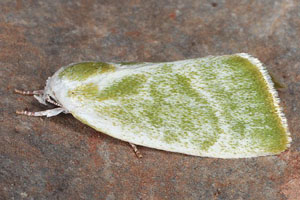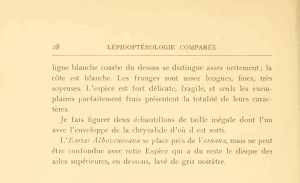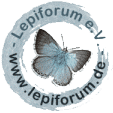

 +4Kontinente:EUAF
+4Kontinente:EUAF1. Falter
2. Identification
'''Adult:''' Resembles ''Earias vernana'' but shows, in addition to the cross-lines, irregular dark green markings in the median field and a dark patch near the posterior margin in the basal field. Sometimes a subterminal line consisting of dark green spots is present. (All these markings are absent in ''E. vernana''). The postmedial line is more rounded and meets the posterior margin strongly bent toward the wing base.
2.1. Similar species
2.2. First publication
3. Further information
3.1. Etymology (explanation of name)
Derived from ''albus, -a, -um'' (lat.) white, and ''venosus, -a, -um'' (lat.) veined; because of the whitish veins in the subterminal field. The ending ''-ana'' is the traditional ending for tortricids (Tortricidae) introduced by Linnaeus and often adopted by later authors. It goes without saying that Charles Oberthür did not take the species for a tortricid; instead he chose this ending to harmonise with those of the other ''Earias'' species. (Text: Axel Steiner)
3.2. Synonyms
- ''Earias vernana'' sensu auctorum (misidentifications)
3.3. Taxonomic note
The species was described from Algeria in 1917 but remained little known. In Europe it was confused with ''Earias vernana'' or taken for a form of this species. It was not until the early 21st century that its occurrence in the Iberian Peninsula and in Sicily was reliably established (Fibiger & al. 2009).
3.4. Distribution
North Africa (Algeria, Morocco), Iberian Peninsula (Portugal, Spain), Sicily.
3.5. Literature
- Fibiger, M., Ronkay, L., Steiner, A. & Zilli, A. (2009): Noctuidae europaeae. Vol. 11. Pantheinae – Bryophilinae. — Sorø (Entomological Press). 504 S., 13 col. pls. ISBN 978-87-89430-14-0
- First publication: Oberthür, C. (1917): Études de lépidoptérologie comparée 13: 1-76, pl. I-XX. Rennes (Imprimerie Oberthür). [digital representation at www.archive.org]








